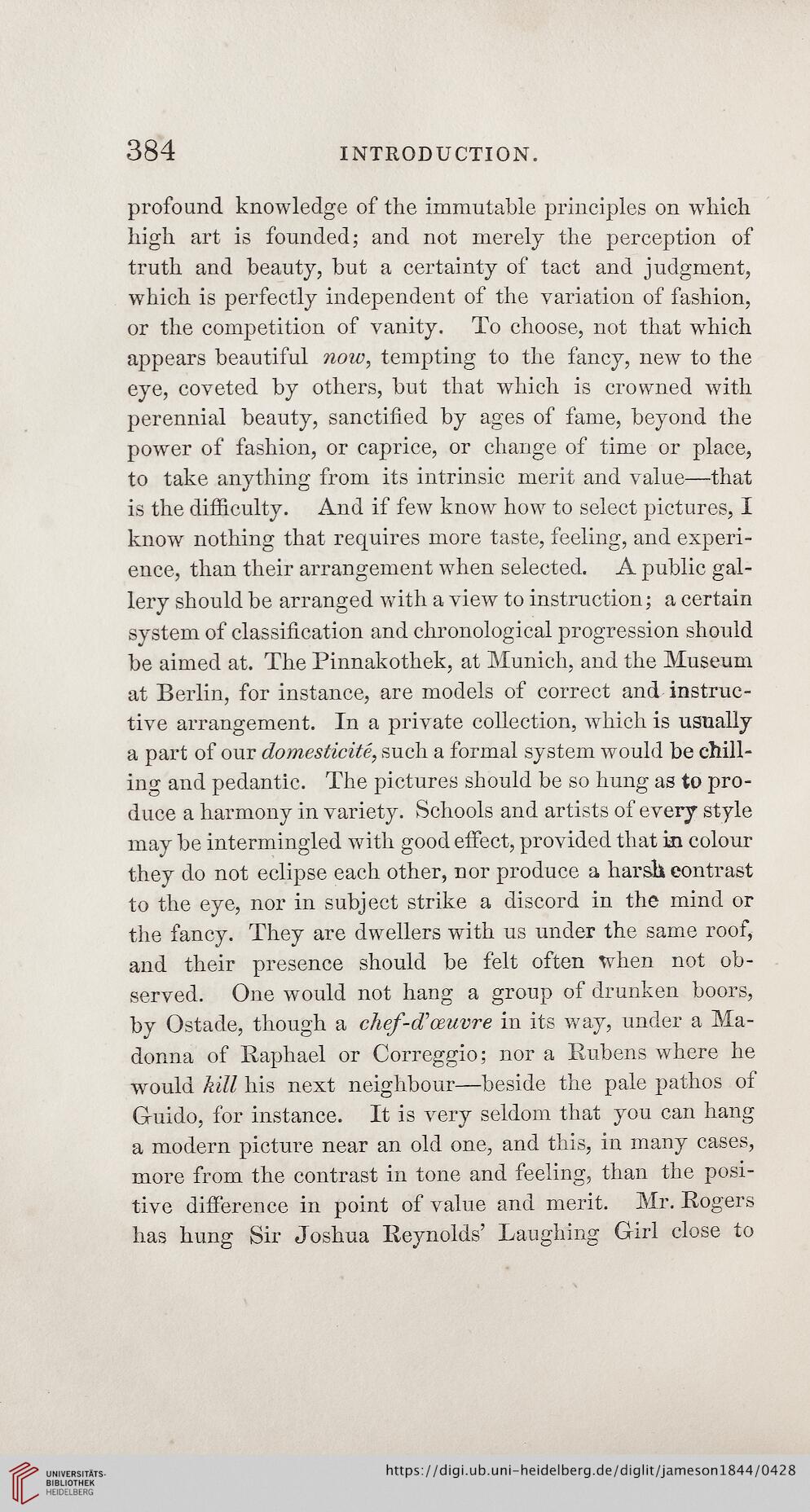384
INTRODUCTION.
profound knowledge of the immutable principles on which
high art is founded; and not merely the perception of
truth and beauty, but a certainty of tact and judgment,
which is perfectly independent of the variation of fashion,
or the competition of vanity. To choose, not that which
appears beautiful now, tempting to the fancy, new to the
eye, coveted by others, but that which is crowned with
perennial beauty, sanctified by ages of fame, beyond the
power of fashion, or caprice, or change of time or place,
to take anything from its intrinsic merit and value—that
is the difficulty. And if few know how to select pictures, I
know nothing that requires more taste, feeling, and experi-
ence, than their arrangement when selected. A public gal-
lery should be arranged with a view to instruction; a certain
system of classification and chronological progression should
be aimed at. The Pinnakothek, at Munich, and the Museum
at Berlin, for instance, are models of correct and instruc-
tive arrangement. In a private collection, which is usually
a part of our domesticite, such a formal system would be chill-
ing and pedantic. The pictures should be so hung as to pro-
duce a harmony in variety. Schools and artists of every style
may be intermingled with good effect, provided that in colour
they do not eclipse each other, nor produce a harsh contrast
to the eye, nor in subject strike a discord in the mind or
the fancy. They are dwellers with us under the same roof,
and their presence should be felt often when not ob-
served. One would not hang a group of drunken boors,
by Ostade, though a chef-d'oeuvre in its way, under a Ma-
donna of Raphael or Correggio; nor a Rubens where he
would kill his next neighbour—beside the pale pathos of
Guido, for instance. It is very seldom that you can hang
a modern picture near an old one, and this, in many cases,
more from the contrast in tone and feeling, than the posi-
tive difference in point of value and merit. Mr. Rogers
has hung Sir Joshua Reynolds’ Laughing Girl close to
INTRODUCTION.
profound knowledge of the immutable principles on which
high art is founded; and not merely the perception of
truth and beauty, but a certainty of tact and judgment,
which is perfectly independent of the variation of fashion,
or the competition of vanity. To choose, not that which
appears beautiful now, tempting to the fancy, new to the
eye, coveted by others, but that which is crowned with
perennial beauty, sanctified by ages of fame, beyond the
power of fashion, or caprice, or change of time or place,
to take anything from its intrinsic merit and value—that
is the difficulty. And if few know how to select pictures, I
know nothing that requires more taste, feeling, and experi-
ence, than their arrangement when selected. A public gal-
lery should be arranged with a view to instruction; a certain
system of classification and chronological progression should
be aimed at. The Pinnakothek, at Munich, and the Museum
at Berlin, for instance, are models of correct and instruc-
tive arrangement. In a private collection, which is usually
a part of our domesticite, such a formal system would be chill-
ing and pedantic. The pictures should be so hung as to pro-
duce a harmony in variety. Schools and artists of every style
may be intermingled with good effect, provided that in colour
they do not eclipse each other, nor produce a harsh contrast
to the eye, nor in subject strike a discord in the mind or
the fancy. They are dwellers with us under the same roof,
and their presence should be felt often when not ob-
served. One would not hang a group of drunken boors,
by Ostade, though a chef-d'oeuvre in its way, under a Ma-
donna of Raphael or Correggio; nor a Rubens where he
would kill his next neighbour—beside the pale pathos of
Guido, for instance. It is very seldom that you can hang
a modern picture near an old one, and this, in many cases,
more from the contrast in tone and feeling, than the posi-
tive difference in point of value and merit. Mr. Rogers
has hung Sir Joshua Reynolds’ Laughing Girl close to




